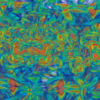Whether it’s Mozart or metal, listening to music can be an intense, even euphoric experience. Hearing your favourite tune might bring up joyful memories soaked in nostalgia, while a soaring melody might send a chill down your spine.
This tingly ‘chill’ sensation you feel can actually be seen on brain scans; has been linked to an activation of the brain’s reward and pleasure systems in previous brain imaging studies. Now, scientists have analysed the patterns of brain activity associated with pleasurable musical chills.
In this study, a high-density EEG device was used to measure waves of electrical activity in people’s brains as they listened to music with headphones in their ears and electrodes on their scalps.
The research team asked 11 women and 7 men (who said they often experience waves of musical pleasure) to listen to a 15-minute collection of 90-second sound bites. Some excerpts were taken from the participants’ favourite chill-inducing music, and other recordings were selected by the researchers.
Previously, research has shown that musical chills occur in two phases: the anticipation before peak-chill as the music is building and the pleasure is growing, which is followed by a second peak pleasure phase.
The 18 music lovers in this study, rigged up to an EEG, reported when they felt a chill coming on. More than 300 hair-raising, goosebump-making chills were recorded, each lasting roughly 9 seconds on average.
But looking at the EEG readings, the researchers were able to detect other chills outside of these predicted moments as well.
And some people’s results had to be excluded from the analysis if, for example, they experienced zero instances of musical chills during the experiments.
The good news is that the researchers found no relationship between the number of pleasurable chills experienced and the years of musical training a person may have had – meaning even if you lack musical talent, that’s no barrier to feeling chills. You can still enjoy music all the same.
Further analysis of the EEG results showed that when participants experienced a chill and their arousal ratings increased, brain activity also increased in the prefrontal cortex, the front lobe of the brain.
Using an algorithm, the researchers traced this activity, at the surface of the brain, down to an activation of the orbitofrontal cortex, a brain region which sits above the eye sockets, integrates sensory experiences and processes emotions.
They also identified two specific patterns of chills associated with activity in the mid-brain supplementary motor area (or SMA) and the right temporal lobe, a region which processes sounds and may be related to musical appreciation.
The results are in line with findings from previous imaging studies also showing activation of these brain regions, which can trigger the brain’s reward systems and release of the ‘feel-good’ hormone, dopamine.
The study also unlocks new avenues for research.
“The fact that we can measure this phenomenon with EEG brings opportunities for study in other contexts, in scenarios that are more natural and within groups,” said neuroscientist Thibault Chabin from the University Burgundy Franche-Comté in France.
Unlike brain imaging machines, wireless EEG instruments are easily transportable and as this study shows, EEG could be a promising tool for measuring musical pleasure in a concert hall or at a show.
Doing so might produce somewhat different results to these lab experiments, since the 18 people involved in this study were expecting to feel chill-inducing moments.
Plus, further research could tell us more about why listening to live music can be such a rewarding experience, or how the pleasure of good music is shared amongst friends and in groups (which some of us might be sorely missing in these pandemic times).
“We want to measure how cerebral and physiological activities of multiple participants are coupled in natural, social musical settings,” said Chabin.
“Musical pleasure is a very interesting phenomenon that deserves to be investigated further, in order to understand why music is rewarding and unlock why music is essential in human lives.”
The research was published in Frontiers in Neuroscience.



